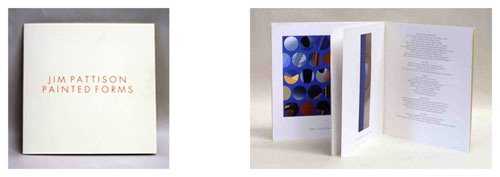Painted Forms
Painted Forms, 1997
Published by Duncan of Jordanstone College, ISBN 1899837 16 7
Alan Woods
‘I have a great loyalty to painting” – a remark of Jim Pattison’s which directs our attention to the essential pleasures and intricacies of his work- for both artist and viewer. There is an interest in the qualities of (acrylic) paint as paint, as canvas a and stretcher as self sufficient (and increasingly sculptural) objects, which suggests the purest minimalism; but enfolded within it there is a balancing interest in and insistence on paint as a representational medium – as the next stripe begins to evoke surfaces outwith the vacuum of abstraction, as the next area of colour reveals itself irresistibly to be a detail, a fragment of a simplified and inaccessible whole, as (often) the eye is overwhelmed into a an involuntary reflex of reading the surface as three-dimensional. It is a dialectic revealed also, as one gets closer to the surfaces of the paintings, in the play of textures not always apparent from distance. Both elements were also apparent in the Vienna series at the beginning of the nineties, but there the fragments of three-dimensional form were, often more lyrical, evocative, glimpse like, and the abstract elements became frames within frames around them.
Pattison is still moving from small initial collages made up from, (mostly glossy) magazines and catalogues and brochures, ‘sketches’ which he uses to stretch his imagination – not only through the chance encounters inherent in this technique, but also to prevent him settling into a particular range of colour combinations; and in many ways collage is a more useful word to put beside his work than the increasingly threadbare term of abstraction. Abstraction to the collagist is simply something else that can be added to the mix, set next to something else. Collage also implies wit, and play, and knowingness, and knowledge of history. It was, of course, a key cubist technique and this work is a kind of cubism able to consider the post-cubist history of twentieth century painting. What the move from paint involves here is a move towards formal values and games with the viewer; the mass-produced source (mass produced images of mass produced objects) is transformed into a unique art-object.
We are given less opportunity to imaginatively expand the fragments; they have become more like diagrams, they often appear aggressively blocked off from us, at the same time they have a more immediate illusionistic impact. The eye is no longer soothed nor directed to a clear centre of interest.
Published by Duncan of Jordanstone College, ISBN 1899837 16 7
Alan Woods
‘I have a great loyalty to painting” – a remark of Jim Pattison’s which directs our attention to the essential pleasures and intricacies of his work- for both artist and viewer. There is an interest in the qualities of (acrylic) paint as paint, as canvas a and stretcher as self sufficient (and increasingly sculptural) objects, which suggests the purest minimalism; but enfolded within it there is a balancing interest in and insistence on paint as a representational medium – as the next stripe begins to evoke surfaces outwith the vacuum of abstraction, as the next area of colour reveals itself irresistibly to be a detail, a fragment of a simplified and inaccessible whole, as (often) the eye is overwhelmed into a an involuntary reflex of reading the surface as three-dimensional. It is a dialectic revealed also, as one gets closer to the surfaces of the paintings, in the play of textures not always apparent from distance. Both elements were also apparent in the Vienna series at the beginning of the nineties, but there the fragments of three-dimensional form were, often more lyrical, evocative, glimpse like, and the abstract elements became frames within frames around them.
Pattison is still moving from small initial collages made up from, (mostly glossy) magazines and catalogues and brochures, ‘sketches’ which he uses to stretch his imagination – not only through the chance encounters inherent in this technique, but also to prevent him settling into a particular range of colour combinations; and in many ways collage is a more useful word to put beside his work than the increasingly threadbare term of abstraction. Abstraction to the collagist is simply something else that can be added to the mix, set next to something else. Collage also implies wit, and play, and knowingness, and knowledge of history. It was, of course, a key cubist technique and this work is a kind of cubism able to consider the post-cubist history of twentieth century painting. What the move from paint involves here is a move towards formal values and games with the viewer; the mass-produced source (mass produced images of mass produced objects) is transformed into a unique art-object.
We are given less opportunity to imaginatively expand the fragments; they have become more like diagrams, they often appear aggressively blocked off from us, at the same time they have a more immediate illusionistic impact. The eye is no longer soothed nor directed to a clear centre of interest.
